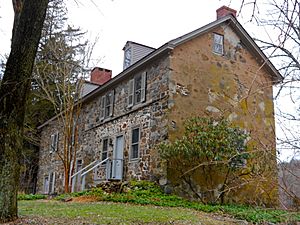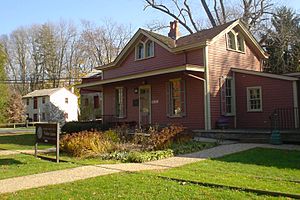Newlin Mill Complex facts for kids
|
Newlin Mill Complex
|
|
|
North side of the mill building
Logo
|
|
| Location | U.S. 1 and Cheyney Road, Glen Mills, Pennsylvania |
|---|---|
| Built | 1704 |
| NRHP reference No. | 83002240 |
Quick facts for kids Significant dates |
|
| Added to NRHP | March 9, 1983 |
The Newlin Mill Complex, also called The Newlin Grist Mill, is a historic water-powered mill. It sits on the west branch of Chester Creek near Concordville, Pennsylvania. Nathaniel and Mary Newlin built it in 1704. This mill worked as a business until 1941. Over its long history, it was known by several names, like the Lower Mill and the Concord Flour Mill.
In 1958, E. Mortimer Newlin bought the mill property. He had it restored and gave it to the Nicholas Newlin Foundation. Today, it is a historical park. The mill still uses water power to grind corn meal, which you can buy there. The park has five old buildings. These buildings were added to the National Register of Historic Places in 1983. The park also includes 150 acres (61 ha) of natural woodland.
Contents
The Mill's Early History (1683-1739)
Nicholas Newlin was a member of the Religious Society of Friends, also known as Quakers. He was an Irishman who lived in Mountmellick, Ireland. In May 1683, Newlin left Ireland to escape religious persecution. This means he was treated unfairly because of his beliefs. He sailed to Pennsylvania with his wife, Elizabeth, and their three children.
In October 1683, Nicholas Newlin bought the mill property from William Penn. This land was in Concord Township. It was about 10 miles (16 km) northwest of the town of Chester. Nicholas Newlin was an important person in the area. He served on the province's governing body, the Provincial Council. He also worked as a Justice of the Peace and in the courts of Chester County.
Nicholas's son, Nathaniel, married Mary Mendenhall in 1684. Mary received more land as a gift to her and her siblings in 1685.
Building the Newlin Mill
Nathaniel and Mary Mendenhall built the current mill in 1704. It was the third gristmill in the township. Nathaniel also served as a Justice of the Peace and in the courts. He was part of the Provincial Assembly from 1698 to 1722. Nathaniel inherited land from his father. Mary also owned land. They bought 7,750 acres (3,136 ha) that became Newlin Township. This made them one of the biggest landowners in Chester County.
When Nathaniel Newlin passed away in 1729, his land was divided among his children. His oldest son, Nicholas, received a larger share. His daughters and other sons, including another son named Nathaniel, each received a single share.
The Mill's Later History (1739-Today)
In 1739, Nathaniel's grandson, Nathaniel Newlin III, built a house for the head miller. In 1742, William and Anne Trimble, who owned a nearby mill, built a house overlooking the Newlin mill. A mile to the west, in Concordville, Nathaniel's son Nicholas built the Nicholas Newlin House in 1742. This house is also listed on the National Register of Historic Places.
In 1777, the Battle of Brandywine happened just a few miles from the mill. General George Washington ordered millstones removed from nearby mills. This was to make it harder for British troops to get supplies. We don't know if this order affected Newlin Mill.
Southeastern Pennsylvania was a major producer of grain long ago. Mills could easily get power from the fast-flowing streams in the area. This area is called the Fall Line. By 1781, Chester County had 127 gristmills. This county included what is now Delaware County. The Newlin mill mostly served local needs. It was known as a "country mill." This meant it produced flour for local use, not for big cities or export.
The Newlin family owned the mill until 1817. They sold it to William Trimble, Jr. Thomas Newlin, who died in 1811, had remarried. His children from his two marriages disagreed about his estate. This led to a large debt against his property, forcing the mill to be sold.
Modern Changes and Preservation
The Philadelphia and Baltimore Central Railroad was built through the property in 1859. This allowed the mill to sell its flour in Philadelphia and Baltimore. A railway station was built in 1868. Samuel Hill bought the mill in 1869. In 1942, the mill stopped making products for sale. The buildings were used as a bookstore and an antique shop for a while.
In 1956, E. Mortimer Newlin bought the property. He was a descendant of Nicholas Newlin. He later started the Nicholas Newlin Foundation. This foundation was created to restore and protect the mill. The mill was restored in 1962 and again in 1992.
| Who Owned the Mill Site | ||||||
| Dates of Ownership | Owner | Notes | ||||
| Sep 24, 1683-1685 | Nicholas Newlin (1630–1699) | Bought 500 acres (202 ha) from William Penn | ||||
| Apr 17, 1685-1729 | Nathaniel Newlin (1663–1729) | Received 250 acres (101 ha) as a wedding gift. Built the mill in 1704. | ||||
| 1729-1768 | Nicholas Newlin (1689–1768) | Inherited the land and mill from his father. | ||||
| 1768-1811 | Thomas Newlin (1747–1811) | Inherited the land and mill from his father. | ||||
| 1811-1817 | Benjamin Newlin (1784–1873) | Inherited the land and mill from his father. Sold it due to a family lawsuit. | ||||
| Jul 31, 1817-1829 | William Trimble (1766–1842) | Bought 26 acres (11 ha), the mill, and 2 houses for $9,005. | ||||
| 1829-1835 | Abraham Sharpless (1748–1835) | Bought 26 acres (11 ha), the mill, and 2 houses for $5,500. | ||||
| 1835-1869 | Casper Sharpless (1805–1865) | Inherited the land and mill from his father. The mill was not sold for 4 years after his death. | ||||
| Apr 21, 1869-1880 | John H. Hill (1799–1880) | A relative of the Newlin family. Bought the mill and land for $25,500. | ||||
| 1880-1929 | Samuel Newlin Hill (1842–1929) | Inherited the land and mill from his father. | ||||
| 1929-1942 | William W. Hill (1863–1943) | Inherited the land and mill from his father. The mill stopped working commercially in 1942. | ||||
| Oct 27, 1942-1956 | Daniel I. Conlon | Planned to turn the mill into a home. | ||||
| Mar 2, 1956-1960 | E. Mortimer Newlin (1898–1977) | A 7th-generation descendant of Nathaniel Newlin. His first purchase included the mill, warehouse, miller's house, and 3.5 acres (1.4 ha). | ||||
| Dec 2, 1960–present | Nicholas Newlin Foundation | Started by E. Mortimer Newlin to protect the mill. | ||||
| From Nicholas Sellers, Short History of Newlin Grist Mill, p. 22. | ||||||
Buildings at Newlin Mill
The Mill Building
The mill building is 35 feet (11 m) wide and 70 feet (21 m) long. A stone on the outside wall shows "Nathan'l Mary Newlin 1704." The dam and the half-mile (0.8 km) mill race were built in the same year. The mill race is a channel that brings water to power the mill. The first grindstone came from France. The mill was built into a hillside. The north side has two stories, and the south side has one.
The mill wheel was first outside the mill. It was likely a breastshot wheel, meaning water hit it in the middle. It was rebuilt in 1976. This wheel weighs 1,500 pounds (680 kg) and is 16 by 4 feet (4.9 by 1.2 m) with 52 buckets. The water flows out underground through the tail race. It then travels about 150 yards (137 m) back to Chester Creek. The floors and machinery inside the mill are held up by a hurst frame. This is a special timber frame that keeps vibrations from damaging the outer stone walls. You can watch how corn is ground at the mill.
After 1817, William Trimble made the mill bigger and put the mill wheel inside. At that time, it ground about 60,000 bushels of corn each year. Before 1850, the mill was updated with the Oliver Evans automated mill design. This made it more efficient. It then started grinding wheat flour. In 1850, the owner, Casper Sharpless, bought 20,000 bushels of wheat for $22,000. He sold flour worth $30,000.
In 1870, the mill produced these items:
| What the Mill Produced in 1870 | ||||||
| Products | Amount Bought | Cost to Buy | Milled Product | Amount Made | Money Earned | |
| wheat | 25,000 bu. | $31,250 | flour | 5,000 bu. | $35,000 | |
| corn | 25,000 bu. | $22,500 | meal | 750 tons | $25,000 | |
| other | 1,000 bu. | $600 | meal | 35 tons | $1,600 | |
| plaster | 225 tons | $1,575 | plaster | 225 tons | $2,000 | |
| From Nicholas Sellers, Short History of Newlin Grist Mill, p. 37. Data from the Federal Manufacturing Census of 1870. | ||||||
At that time, the mill had four millstones. It also had two wooden overshot water wheels. These wheels had a 24-foot (7.3 m) drop for the water. They produced about 20 horsepower. An upper story made of wood was added around 1890.
The Warehouse
The warehouse is a 2.5-story stone building. It is located east of the mill's lower level. Nathaniel Newlin built it after the mill. He used it as a store for dry goods. Today, it holds the Foundation's historical records.
The Miller's House
This stone house was built in 1739. It is next to the south side of the mill. It has two rooms on each of its two floors. Each room has a fireplace. There is also a beehive oven attached to the kitchen. A third story was added around 1860. It was removed during a restoration in the 1960s. This house is different from the Newlin Miller's House about 12 miles (19 km) north in West Whiteland Township. That house was built later and is listed separately.
The Trimble House
(The image shown is of the main office, not the Trimble House.) This house was built into the hill above the mill and the miller's house in 1742. It also had four rooms. By 1765, it was made larger for William Trimble's growing family. It has nine fireplaces. There is a 53-foot (16 m) deep well. Much of the original floor, wood, doors, and hardware are still there. The Newlin Foundation bought the house in 1998. It is now used as a private home.
The Railway Station
This 1.5-story Gothic-style station was built in 1868–1869 by Samuel Hill. It served as a post office and a place for people to vote for the mill workers in the area. It burned down in 1890. It was rebuilt the next year. It was used as a railway station until the 1930s. Now, it is the park office.
The Park Grounds
The five original buildings are the main part of a 150-acre (61 ha) park. Most of the park is natural woodlands. A springhouse from a local farm, built in 1710, was moved to the park in the 1970s. A small barn was moved from northern Delaware to the area behind the miller's house. In 1965, a log cabin was built. It is used for meetings, parties, and other events. A new replica of an 18th-century blacksmith shop was built in 1975. The park also includes two ball fields.
Images for kids













